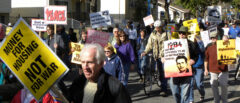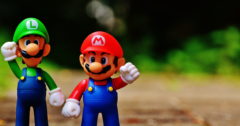In her groundbreaking essay Sex and Death in the Rational World of Defense Intellectuals, Carol Cohn recounts the often sexually-charged, firmly patriarchal idiolect of the defense intellectuals she spent time with during a year of fieldwork. She argues that the gendered metaphors that run rampant through the discourse of the United States nuclear establishment are part of a larger system of abstraction that allows war-planners the pretense of “rational” thought. Plans for “limited” nuclear wars and elaborate deterrence strategies exist primarily in the imaginations of the initiated, Cohn says, and betray the fact that the safety of the nuclear weapons themselves is valued above all by nuclear war planners. “Speaking technostrategic language,” Cohn observes, “removes them from the position of victim and puts them in the position of the planner, the user, the actor.”
Cohn remarks that the sexual imagery used in conversation by the men she worked with was “transparent,” which is to say, unsubtle to the point of disbelief. The same holds for the beauty queens of the atomic age’s early years—the iconic image of a smiling woman posing with a cotton-ball mushroom cloud attached to her white bikini is both charmingly kitschy and obviously macabre, and Cohn’s reading of the bomb’s symbolism as “the ultimate power of violent domination over female Nature” does not seem out of place.
Cohn was writing in the 1980s, but the subculture of the nuclear elite that she was writing about had existed in more or less the same form for decades.
The lurid absurdity that Stanley Kubrick immortalized in Dr. Strangelove with General Jack D. Ripper’s fretting over his “precious bodily fluids” and the dubiously-named General Buck Turgidson is nowhere more obvious in America’s nuclear history than in the story of the atomic beauty queens of the 1950s.
From 1952 to 1957, four women were chosen to serve as the cheery, attractive face of the newly “nuclear” Las Vegas—which seven decades ago had not yet become the preeminent destination for spendy debauchery it is today. The city’s brief tenure as “Atomic City, U.S.A.” began after the “Able” nuclear test took place at the nearby Nevada Test Site on January 27, 1951. The Las Vegas Chamber of Commerce leaped at the opportunity to associate itself with an exciting new period of technological ascendancy, publishing calendars with test schedules and organizing themed parties, while hotels advertised good views and comfortable surroundings in which to watch a test. The beauty queens of the early atomic age were just one part of the city’s burgeoning tourist industry.
Nominations for atomic beauty queenhood were hardly meritocratic, even by beauty-contest standards: contestants were recruited from the ranks of women already working as performers in Las Vegas, and were not required to have any special connection to the nuclear establishment. The best remembered of these women remains, in many ways, largely anonymous: she was known pseudonymously as Lee A. Merlin, and researchers and history buffs have tried without success to uncover more information about her.
As the United States’ nuclear program grew, so did the city. By 1963, when the Partial Nuclear Test Ban Treaty put an end to above-ground nuclear tests, Las Vegas had developed beyond its role as homeland for the United States’ nuclear pop culture. But the phenomenon experienced a post-millennial revival from 2004-2011 with Russia’s “Miss Atom” contest.
There was no Soviet counterpart to the atomic beauty queen of 1950s Las Vegas, perhaps because the postwar Soviet nuclear program was subject to a higher level of secrecy than its U.S. counterpart. However, since the beginning of the 2000s Russia has placed a greater emphasis on its nuclear power program, and has become a major provider of nuclear technology for civilian purposes on international markets. As with its American predecessor, a beauty contest was a uniquely effective way to put an attractive human face on an ambitious program of economic and technological development.
The contest, held for the first time in 2004, was sponsored by state-owned corporation Atomenergoprom, which controls Russia’s civilian nuclear industry. Nevertheless, it came off as more-or-less homegrown—all women working in Russia’s nuclear power industry were eligible to compete, and prizes included home electronics and a bottle of liquor. Though voting was open, the contest was most enthusiastically received abroad, by Russia watchers of all stripes.
The tradition lives on even today, albeit in a less exalted context—the National Nuclear Research University in Moscow hosts a “Mister and Miss Atomic” pageant yearly, with additional categories including Misters Energy and Gallantry, and a generous roster of Vice- Misters and Misses.
Many have noted that, for better or for worse, nuclear weapons play a much less prominent role in Americans’ worldview than they did in decades past—even though by many measures the threat of nuclear war is greater now than it was at the most tense moments of the Cold War. The atomic beauties of the past were deployed to impart optimism and playfulness to technologies that promised to bring power and security to the countries that developed them, and to reassure the public that these technologies do not pose a domestic threat. With a president in office whose enthusiasm for both arms races and beauty contests is well-documented, it stands to reason that there could even be a new atomic pageant on the horizon. But in a new era of action against sexual harassment, and with fewer and fewer people trusting the President with the ability to launch a nuclear attack, would anyone tune in?


